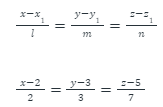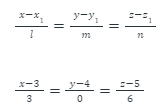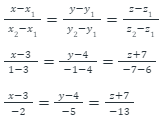A line is a one-dimensional figure that only has length; it has no width. The cartesian plane allows the representation of the equation of a figure in three-dimensional analysis. The x-axis, y-axis, and z-axis represent the equation of a line on a cartesian plane.
The most basic form of the cartesian equation of a line is of the vector form:
A→= xi→+yk→+xk→
We can also represent this expression as A(x, y, z). The x, y, and z coordinates represent the coordinates of the line. Let us learn about the equation of a line on a cartesian plane.
Equation of a Line on Cartesian Plane
The standard form of the equation of a line is as below:
y=mx+c
Here, m is the slope of the line, and c is the y-intercept. We can represent the equation of the line in vector form. In vector form, we get the direction of the line as well.
For writing the equation of a line in the cartesian form, let us understand this with one example. Suppose two coordinates of a line are (x1, y1, z1) and (x2, y2, z2).
To calculate the equation of a line on a cartesian plane, we follow the steps below:
Calculate Direction Ratios
To calculate the direction ratios, we simply determine the difference between the coordinates of the corresponding points.
l, m, and n are the direction rations.
For the next step, we take either of two points. Let us take (x1, y1, z1).
Substituting all the values in the cartesian form of a line:
The above is the general case of the cartesian equation. The parametric form is as below:
Therefore, the coordinates of a line are given as:
(l+x1, m+y1, z+z1)
Illustration: A straight line passes through two given points, A (2, 3, 5) and B (4, 6, 12), then find the equation of a line in cartesian form.
Solution: We have A (2, 3, 5) and B (4, 6, 12)
l = (4 – 2) = 2
m = (6 – 3) = 3
n = (12 – 5) = 7
Let us choose one point, say point A (2, 3, 5).
Substituting the values in the standard form of the cartesian equation of a line, we get:
This expression is the required equation of a line in the cartesian plane.
Illustration: What are the direction ratios of a line with coordinates P (2, 4, 6) and (3, 5, 4)?
Solution: The direction ratios of the line are:
l = (x2-x1) = (3-2)=1
m=(y2-y1) = (5-4)=1
n=(z2-z1)= (4-6) = -2
Hence the direction ratios are <1,1,-2>
Illustration: A straight line passes through the two fixed points in the 3-dimensional whose position coordinates are P (3, 4, 5) and Q (6, 4, 11), then what is its cartesian equation using the two-point form?
Solution: We have P (3, 4, 5) and Q (6, 4, 11), then the direction rations will be:
l = (6 – 3) = 3
m = (4 – 4) = 0
n = (11 – 5) = 6
Let us choose one point, say the point P (3, 4, 5).
Substituting the values in the standard form of the cartesian equation of a line, we get:
This expression is the required equation of a line on a cartesian plane.
Equation of a Line on Cartesian Plane Passing Through Two Points
The cartesian equation of a line passing through two given points is:
Illustration: What is the cartesian equation of a line passing through P (3, 4, -7) and Q (1, -1, 6).
Solution: Let us substitute the values of P and Q in the standard form of cartesian equation of a line.
Conclusion
If we know the coordinates of a line, we calculate its equation in various forms. The line is a one-dimensional geometric figure, but we can represent it in various forms such as:
Standard form: y=mx+c
Cartesian form: x-x1l=y-y1m=z-z1n
Vector form: A→= xi→+yk→+xk→
In this study material notes, we learned how to find a line equation on a cartesian plane. The cartesian plane helps to represent the equation of a line or point in a three-dimensional plane with the x-axis, y-axis, and z-axis.
 Profile
Profile Settings
Settings Refer your friends
Refer your friends Sign out
Sign out












